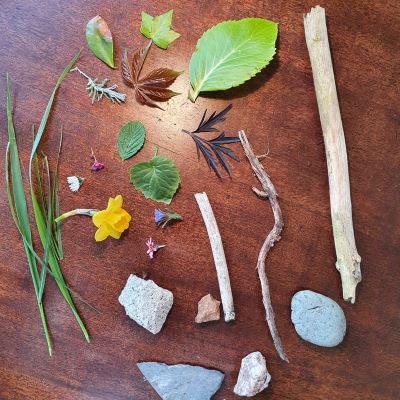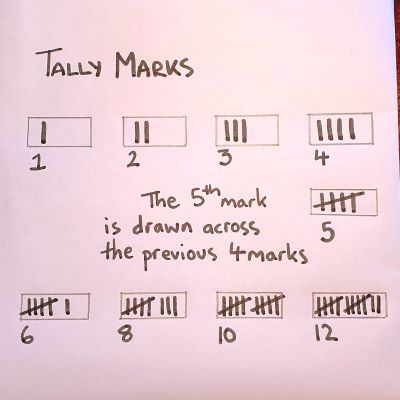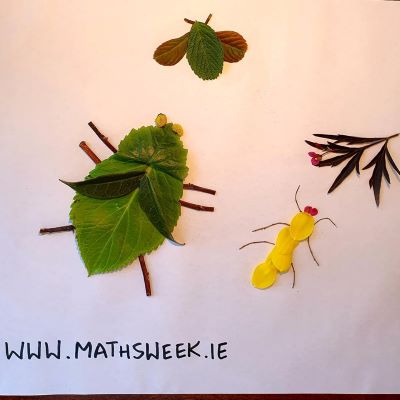Mathematical Nature Scavenger Hunt
Friday 22/05/20
This cross-curricular fun activity celebrates BIODIVERSITY DAY today. It is great way to get children excited about maths and nature. Children will have to look for certain materials found in nature, count them, record their results and communicate their mathematical thinking. By bringing maths into everyday experiences, like exploring in the garden, children can practice their mathematical skills in a meaningful way. This type of activity will deepen their understanding of mathematical concepts as well contribute positively to their wellbeing: spending time in nature has a very positive effect on our mental and physical health.
Consider the biodiversity of your environment (the variety of living things around us). This week we are celebrating biodiversity across Ireland and all over the world: it is International Day for Biological Diversity on 22 May. We can also celebrate biodiversity right at home. Today’s activity will inspire you to explore and discover what is at your doorstep

Search for as many of the following items as possible
Fallen leaves:
- How many fallen leaves can you find?
- Collect some samples of different types of leaves – try get as many different shapes as possible
- Draw a sketch of one of the leaves or make a leaf rubbing
- What type of shape does it have?
- What colour is it?
- How would you describe the texture of the leaf? (waxy/smooth/rough/flimsy/bumpy/crumbly)
- Create a pattern collage with the leaves you have collected
Sticks
- How many sticks can you find on the ground?
- Can you collect 10 sticks?
- Which stick is the longest/shortest/thinnest/thickest?
- How would you describe the texture? (smooth/rough/bumpy/hard/crumbly)
- Arrange the sticks in the row, anyway you like/from smallest to biggest
Feathers
- Can you find any feathers on the ground?
- How many can you collect?
- Which feather is the longest/shortest/biggest/smallest?
- Can you draw a sketch of a feather?
- What colour is it?
Flowers
- How many white/pink/yellow/purple flowers can you see?
- Can you find a flower with 2 petals/3petals/4petals/5petals/many petals? count how many you find and record the results
Animals
- Can you find an animal with 0 legs/ 2 legs/4 legs/ more than four legs?
- Record how many of each differen birds you see in your garden. Put a time limit on it.
- Can you find a group of animals together? Birds/insects/cattle/fish? How many?
- Sort the animals in order of size – draw a picture
- Which is the biggest/smallest/fastest/slowest/heaviest/lightest
- Which is the odd one out? Seagull, Robin, blackbird, cat? Cat, dog, butterfly, cow?
- categorise the animals into furry/not furry
Trees
- How many trees can you see?
- Do they have leaves or not?
- How to the tree differ from one another? What are the differences? Similarities?
- If they have leaves, what colour are they?
- Estimate the number the branches/leaves? Is it possible to count?
- How would you describe the tree? (tall/small/wide/thin/bushy/bare)
- Categorize the trees in terms of size – which one is the tallest/shortest? Which has the thinnest trunk?
- Are there any animals in the tree? Count them
- Take a bark rubbing. How would you describe the texture/colour of the bark?
Human made objects:
- What types of objects can you see in your garden that are not natural?
- How would you describe the shape?
- Can you find an object that you think is heavier that this?
Can you find the following shapes?
- straight line,
- curved line,
- square,
- triangle,
- circle,
- cuboid,
- sphere
Patterns and symmetry
- Can you find any interesting repeating patterns?
- Predict what would come next in the pattern if it were to continue
- Can you create your own repeating pattern with some of the materials you collected?
- Can you find something that has 1 line of symmetry? 2 lines of symmetry? Rotational symmetry?
INSTRUCTIONS
Create a list before you head out, choose as many items as you like. Check out our template below for ideas. Children may like to be involved in this process – brainstorm what natural materials and wildlife you expect/hope to find in the garden.
As an extra challenge you could extend the scavenger hunt to another location and then add the two together. For example, the front garden and the back garden or the local park and the beach.
Children may like to collect some samples (10 – 20) for an art activity later. Please be considerate of the natural environment and only gather objects that have already fallen to the ground.
How to Play:
- Once you have devised a list, take note of the time on the clock, and then head outside.
- Begin by looking for the first object on your list. Count how many of those items you see. For example, there are 3 trees in the back garden
- Write down that number. Or if there are lots of those items it may be a good idea to keep a tally instead (just put marks on a piece of paper but the 5th mark is drawn across the previous 4 marks (see below)
- You may wish to collect some of the natural items for further analysis later (between 10 and 20 items) e.g. sticks, round pebbles, fallen leaves, blades of grass, flower petals, shells)
- Continue through the list, searching for each of the items. Record how many of each kind you find. Take some sketches, tree rubbings or photographs.
- Don’t forget to take your time and look around – you may see some other interesting items that weren’t on your list. What other maths can you see around you?
- When you’re done, look at the results. Which natural item did you find the most of? The least? Which stick is the longest/shortest/thickest/thinnest etc.
- Record the time on the clock again. How long did you spend scavenging?
For: Primary Children
What you will need:
- Pencils
- Hunt list
- Clock
In these difficult times, you may not have all the material suggested. You may need to adapt these activities to suit your needs and materials available. For instance, you could draw out the cards. Maybe your kids could think of ways of adapting and improvising. This is valuable skills development.


Extensions:
Encourage diversity in your garden and create the following:
- Butterfly feeders
- Insect hotels
- Bird feeders
- Bird bath
- Make a mandala
- Mini greenhouse
All these activities are free to download on the Bealtaine Living Earth Website






